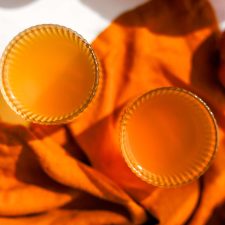Homemade Hard Pumpkin Cider with Warm Fall Spices
Your folders
Your folders
Prep Time: 30 minutes
Cook Time: 30 minutes
Total: 1 hours
Servings: 64
Author : Kaitlynn Fenley

Ingredients
Export 5 ingredients for grocery delivery
Instructions
Step 1
Open a 16 ounce can of pumpkin puree. Place a colander in a large bowl and line the colander with a few layers of cheesecloth or butter muslin. Dump the puree in the cheesecloth-lined colander and allow the pumpkin juice to separate from the pulp, collecting the juice in the bowl. This should give you over 8 fl ounces of pumpkin juice.
Step 2
Clean and sanitize all of your equipment. I like to wash the jug with soap and water, allow it to air dry a bit, then rinse the jug with cheap vodka and allow it to air dry fully.
Step 3
Once your equipment is prepped, add the pumpkin juice, cinnamon, clove and sugar to a small pot, and bring to a simmer. Stir until all the sugar is dissolved.
Step 4
Remove the cinnamon stick and clove. Allow the pumpkin liquid to cool, then, using a funnel, add it to the 1/2 gallon jug.
Step 5
Add in the cider yeast and mix gently by swirling. Wait about 30 minutes for the yeast to get frothy and active.
Step 6
In the meantime, heat the apple juice until simmering. Remove from heat and allow to cool to room temperature (if using a metal pot you can place the pot in a bowl of ice to cool it down faster).
Step 7
Carefully using a funnel, add the apple juice to the jug leaving two inches of headspace.
Step 8
Cap the jug and swirl it around for about a minute.
Step 9
Remove the cap and place the airlock and stopper in the jug (see pictures above).
Step 10
After a few hours, you should notice a lot of bubbling in the cider and activity in the airlock.
Step 11
Allow the cider to ferment for 7 to 14 days until the bubbling completely stops, and you no longer see any activity in the airlock. At this point, you should see a lot of sediment in the bottom of the jug.
Step 12
Racking the cider: Remove the airlock and, using a funnel, transfer the cider to a new, clean jug for aging. Be careful pouring; pour gently and in one steady pour, leaving the sediment in the bottom of the original jug.
Step 13
Cap the jug with a regular lid. Allow the cider to age at a cool room temperature or in the fridge for four weeks.
Step 14
At this point, you can rack the cider again with more aging time or move on to bottling.
Step 15
To Bottle the cider with honey: Clean and sterilize two 1-liter carbonation-safe bottles. Add one tablespoon of honey to each 1-liter bottle. Transfer the cider from the aging jug into the carbonation-safe bottles using a funnel, leaving any sediment in the bottom of the jug. Cap the bottles and invert gently twice to mix the honey with the cider.
Step 16
Allow to ferment in the bottles at a cool room temperature for five days, then immediately store in the fridge. (check the carbonation by carefully opening a bottle over the sink, if it is not carbonated enough, you can leave it at room temperature for seven days.)
Step 17
You can age the cider for 3 more weeks in the fridge before enjoying it chilled. Keep refrigerated.